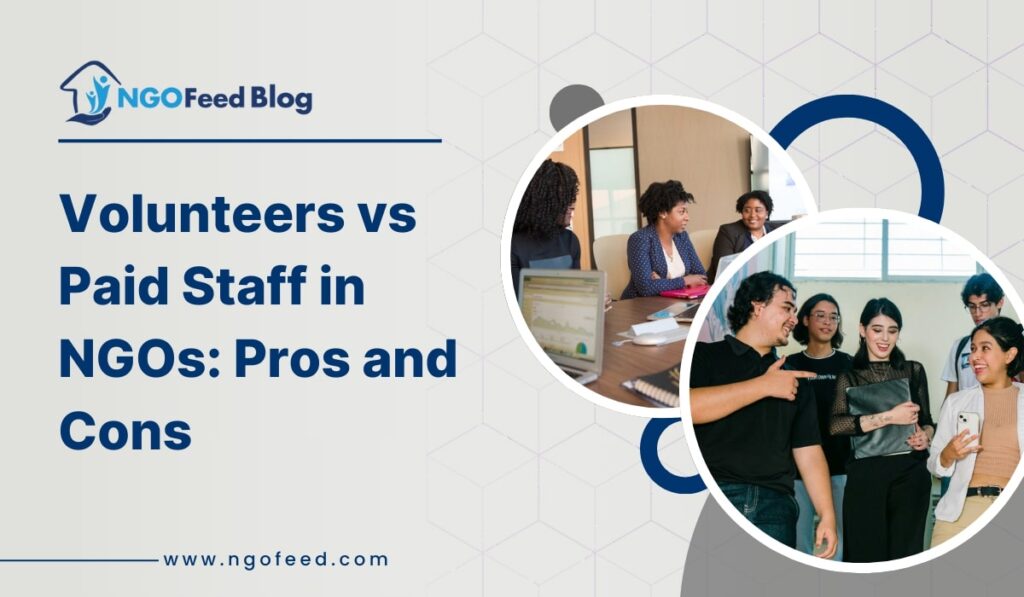Volunteers Vs Paid Staff in NGOs: Non-Governmental Organizations (NGOs) are the spine of civil society, connecting government programs with local needs. Health, education, environment, gender equality, disaster relief, and human rights are among the many fields in which they operate. The success of any non-governmental organization depends mostly on its human resources: the paid employees with professional knowledge and structure as well as the volunteers willing to give their time selflessly.
Paid workers guarantee operational efficiency and continuity, while volunteers bring passion and neighborhood spirit. Dealing with two groups presents problems in motivation, expectations, and sustainability, though. This essay looks at the advantages and drawbacks of volunteer and paid employees, pointing out how NGOs may strike a balance between these responsibilities for greatest social effect.
Table of Contents
NGO Volunteerism
Most NGOs’ emotional and ethical base is volunteers. They capture civic responsibility and the spirit of service. Many nonprofits, especially those founded at the grassroots level, depend mostly on volunteers to carry out projects, plan awareness campaigns, and engage local communities.
Advantages of Volunteers
- Cost-Effective Human Resource: By free financial burdens, volunteers let NGOs use their money for beneficiary services and program development rather than wages.
- Strong passion and drive: Since volunteers work out of compassion and conviction, they bring enthusiasm and sincere concern for the cause —a factor that inspires communities and fosters trust.
- Social and Cultural Representation: Local volunteers frequently share the same cultural, linguistic, and social background as the intended audience, therefore connecting and communicating more naturally.
- Innovative ideas and new viewpoints: Volunteers originate from diverse professional and academic experience. Their different backgrounds sometimes result in innovative project ideas and original problem-solving.
- Public relations and advocacy: Volunteers represent brands. Their word-of-mouth advertising enables NGOs to become noticed and draws in fresh supporters and donors.
- Scalable and flexible labor force: For quick projects like blood donation campaigns, disaster relief, or fundraising events, NGOs can readily gather volunteers.
Also Read: Government Grants vs Corporate CSR Funding
Drawbacks of Volunteers
- Lack of consistency: Availability might affect volunteer involvement, therefore causing projects to be executed inconsistently.
- Limited Responsibilities: Disciplines, deadlines, and performance criteria become challenging to uphold since volunteers are not legally obligated.
- Need of Training and Supervision: Volunteers must be constantly oriented and monitored to guarantee their match with the mission and policies of the NGO.
- Short-Term Dedication: Many volunteers come for short bursts, therefore upsetting institutional continuity and long-term initiatives.
- Dependence on Motivation: Intrinsic motivation is the main driving force behind volunteer participation. High dropout rates can result from burnout, disinterest, or conflicting priorities.
Paid NGO staff members
Paid staff members provide NGOs professionalism, stability, and strategic guidance. Handling administrative, financial, technical, and managerial parts, they make sure that projects are carried out in accordance with donor or government expectations.
Benefits of paid employees
- Expertise and professionalism: Paid workers usually have specialized expertise needed for sophisticated development initiatives, from social work and law to data analysis and project management.
- Reliability and Continuity: Employees, unlike volunteers, have fixed schedules and provide constant output, hence enabling seamless organizational operation.
- Structured Responsibility: Regular performance reviews, specified job roles, and contract duties help one to keep discipline and quality.
- Strategic Planning and Monitoring: Paid personnel are prepared to manage long-term planning, budgeting, and reporting—which are vital for donor trust and sustainability.
- Institution memory: Long-term staff members enable future decision-making by preserving corporate history and customs.
- Government and Donor Compliance: Many funding sources want professional management and documentation, tasks that suitably trained personnel can easily manage.
Disadvantages of Paid Workers
- High Costs of Operation: A large share of an NGO’s budget can go toward salaries, benefits, and overhead costs, therefore lowering the amount of money left over for fieldwork.
- Risk of Bureaucratization: Overly strict hierarchies and formality could restrict adaptability and stifle local invention.
- Motivational hurdles: Some workers may consider their jobs as normal ones, perhaps lacking the emotional engagement volunteers show.
- Financial Dependence: Stable money supports salaried staff roles. Layoffs or operational paralysis may result from any financial deficit or project termination.
- Possible Interior Problems: Sometimes disparities in salary, status, and expectations might cause conflict between paid staff and volunteers.
Also Read: How to Attract Foreign Donors to NGO
Comparative Overview
| Aspect | Volunteers | Paid Staff |
|---|---|---|
| Motivation | Passion-driven, altruistic | Professionally driven, career-oriented |
| Commitment | Often short-term | Long-term and stable |
| Cost to NGO | Low | High |
| Skills | Varies widely | Specialized and consistent |
| Accountability | Limited | High |
| Flexibility | High | Moderate |
| Sustainability | Uncertain | Reliable |
| Community Connection | Strong | May vary |
| Management Requirement | High (for training/supervision) | Moderate (contract-based) |
Finding an equilibrium between paid employees and volunteers
- Many times, the most efficient model for NGOs to flourish is a hybrid one. This combines the professionalism of salaried workers with the excitement of volunteers.
- Paid employees should handle administrative, financial, and technical activities; volunteers can help with outreach, event coordination, and advocacy; and strategic role allocation.
- Offering training programs helps volunteers grasp corporate ethics and professional standards, hence improving coordination with paid staff.
- Awards and Recognition: Certificates, appreciation events, or leadership chances encourage volunteers and reinforce loyalty.
- Transparent communication between the two groups helps to avoid overlap, conflict, and misunderstanding by means of well-defined roles.
- Some NGOs advocate for excellent volunteers for paid jobs to guarantee continuity and keep talent.
- Creating mutual respect between both groups ensures that passion and professionalism coexist harmoniously in a collaborative culture.
Also Read: How to Apply for Government Grants for NGO
Conclusion
An NGO’s strength depends on its people: both paid employees and volunteers. Compassion, social responsibility, and community involvement are qualities found in volunteers. Paid employees give professional administration, consistency, and structure. One helps the other. Paid employees guarantee that the mission functions efficiently within strategic and economic boundaries, while volunteers link emotionally with it.
A sustainable NGO has to combine rather than pick between the two. Proper management turns the cooperation between professional discipline and volunteer passion into the engine for genuine, sustained social transformation.
Frequently Asked Questions (FAQs)
Why do NGOs rely on volunteers?
Volunteers provide manpower, local insight, and community trust, which are crucial for outreach and awareness programs.
Are paid staff more effective than volunteers?
Both are effective in different contexts. Paid staff bring professionalism and consistency, while volunteers bring community engagement and empathy.
How can NGOs motivate and retain volunteers?
Through appreciation, meaningful work assignments, flexible schedules, and opportunities for growth or recognition.
What happens when an NGO depends only on volunteers?
While cost-effective, it may face sustainability and accountability issues, particularly in large-scale or technical projects.
What is the ideal balance between volunteers and paid staff?
A successful NGO integrates both: volunteers handle community-facing roles, and paid staff manage technical and administrative responsibilities.










